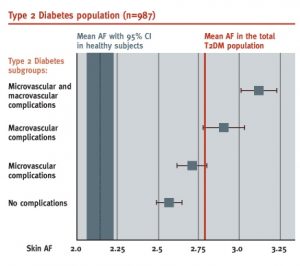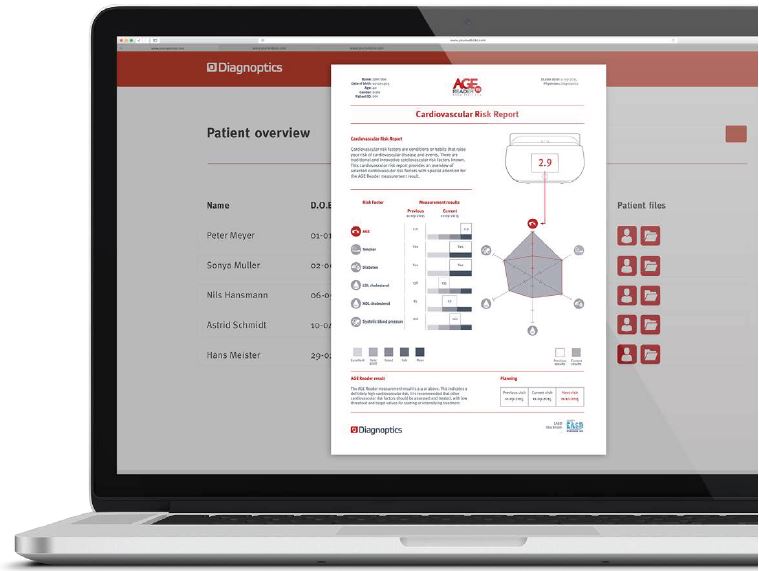Clinical validation
The comfortable and safe AGE Reader measurement offers crucial clinical information to clinicians and researchers. The AGE Reader has validated against the gold standard for measuring AGEs (skin biopsies). This showed skin autofluorescence is strongly correlated with AGEs.
The device has been clinically validated in multiple large-scale, clinical trials over the last few years. These trials involved tens of thousands of healthy controls, diabetics, cardiovascular and renal patients. The clinical studies demonstrate that skin autofluorescence is a strong and independent risk predictor for mortality, diabetic complications and cardiovascular events. In particular, it can independently predict cardiovascular co-morbidity and mortality in diabetes, renal failure and dialysis patients.
Diabetes
Initial clinical studies were performed in diabetes mellitus, because it is the classical example of increased formation and accumulation of AGEs. Skin Autofluorescence was approximately 30% higher in patients with diabetes mellitus (type 1 or 2) compared with age-matched controls. In a large cohort of well controlled primary care patients with type 2 diabetes, the presence and degree of microvascular and macrovascular complications were associated with a graded increase in skin AF (Lutgers 2006). Gerrits et al. (2008) reported that skin AF is associated and predictor of diabetic nephropathy and neuropathy.

The UK Prospective Diabetes Study (UKPDS) risk score has emerged as the most widely used tool to predict complications in type 2 diabetes. Although many type 2 diabetes patients are nowadays controlled tightly according to guidelines for their classic risk factors (for example cholesterol, blood pressure, smoking and HbA1c), they still develop cardiovascular complications. Additionally, risk calculators may underestimate CV risk in patients already treated with anti-hypertensive or lipid-lowering drugs. Consequently there is a need for additional markers among clinicians to identify patients at high risk for developing CV complications.
The publication by Lutgers et al. (2009) in Diabetologia showed that the AGE Reader has additional value in determining cardiovascular risk. Within a group of almost 1000 well controlled (HbA1c: 7%) type 2 diabetes patients in primary care, the AGE Reader measurement was the second best single predictor of cardiovascular and total mortality. The best predictor is biological age. Furthermore this publication demonstrated a combination of AGE Reader measurement and the UKPDS risk score adds prognostic information. Often reclassification from low-intermediate risk to high risk (27%) and vice versa occurs as a result. Thus, without using the AGE Reader, 27% of the patients was incorrectly classified and therefore possibly not treated as desired.
Renal disease
The AGE Reader has also been extensively tested in renal disease which led to important conclusions. Skin auto fluorescence:
- is an independent predictor of cardiovascular disease associated mortality in haemodialysis patients.
- is a strong and independent predictor of mortality and chronic graft loss in renal transplant recipients.
- correlates to arterial elasticity and diastolic function in both haemodialysis and peritoneal dialysis patients.
Cardiovascular disease
Clinical research on the AGE Reader in cardiovascular led to other findings. Skin autofluorescence:
- is an independent marker for acute myocardial infarction.
- indicates future cardiovascular morbidity and mortality in STEMI patients.
- predicts amputations in patients with peripheral artery disease (PAD).
- predicts mortality and coronary events in patients with peripheral artery disease.
Since the introduction of the AGE Reader over 145 peer reviewed papers have been published. These papers supply an extensive clinical validation.
Interested in receiving a white paper and product brochure? Please leave your name and email here.
Would you like to learn more about our products? Request any information you wish to receive here.

Read more »
More information about Diagnoptics.
Information on Diagnoptics' products and Advanced Glycation Endproducts.
Information about Advanced Glycation Endproducts, the AGE measurement and clinical validation.
